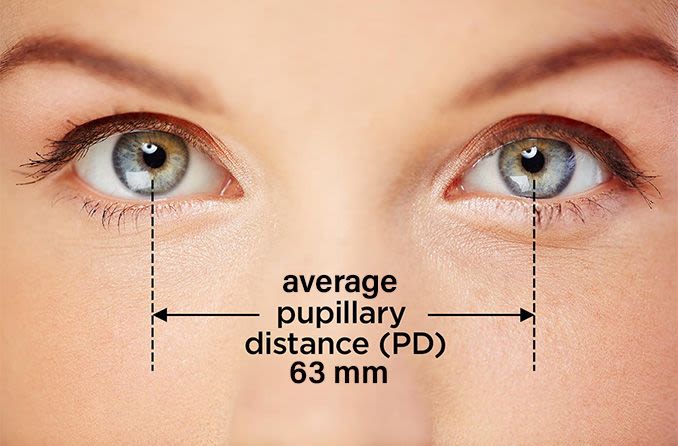What is pupillary distance, and how do you measure it?

What is pupillary distance (PD)?
Pupillary distance (PD) is the distance between the pupils of your two eyes. It is an essential measurement when buying a new pair of eyeglasses or prescription sunglasses. For greatest comfort and clarity, the optical center of each lens of your glasses should be aligned directly in front of the center of your pupil.
PD is measured in millimeters (mm). The average pupillary distance for an adult is about 63 mm, but this is not a number you’ll want to assume. Pupillary distance can vary widely — roughly between 51 mm and 74.5 mm for women and 53 mm and 77 mm for men.
Monocular vs. binocular PD measurements
There are two types of pupillary distance measurements:
Monocular PD. This is the distance between the center of your pupil and the middle of the bridge of your nose. Monocular PDs are required for accurate fitting of progressive lenses.
Binocular PD. This is the distance between the center of the pupil of one eye and the center of the pupil of the other eye.
Due to facial asymmetry, monocular PDs aren’t always exactly the same. But the sum of your two monocular PD measurements should always equal your binocular pupillary distance.
How to measure pupillary distance
Pupillary distance measurements usually are taken when you are being fitted for glasses after your eye exam. An optician typically will measure your PDs with a high-precision measuring device called a pupillometer.
But let’s say you have your eyeglass prescription and want to buy a stylish pair of eyeglasses online. You need your PD measurement for that.
Don’t worry. You can measure your own PD in a pinch. All you need is a millimeter ruler and a mirror.
Here are the basic steps for measuring your PD:
Stand in front of a mirror (about 12 inches away).
Hold a millimeter ruler horizontally, just above your eyes and flat against your eyebrows.
Close your right eye.
With your left eye, align the ruler’s zero mark to the center of the pupil of your left eye.
Without moving the ruler, close your left eye and open your right eye.
Find the millimeter mark on the ruler that is aligned with the center of the pupil of your right eye. Record this measurement. This is your distance binocular PD.
For reading glasses, subtract 3 mm from your distance binocular PD. This is your near PD.
You may want to repeat these steps a few times to ensure you are consistent with your PD measurements.
PD measurement: Alternate method
If you already wear prescription eyeglasses, here’s an alternate way to measure your pupillary distance. You just need a non-permanent marker for this one.
Wearing your glasses, stand in front of a mirror (about 12 inches away).
Close your right eye.
Using just your left eye, put a small mark on the left lens of your glasses, directly in front of your pupil.
Without moving your head, close your left eye and open your right eye.
Using just your right eye, put a small mark on the right lens of your glasses, directly in front of that pupil.
Take off your glasses and measure the distance between the two dots on your glasses. This is your distance binocular PD.
Note: Do-it-yourself PD measurements frequently are not as accurate as the pupillary distance measurements taken by a skilled optician. For best results, have an eye care professional measure your pupillary distance (PD) before buying new glasses.
READ NEXT: What is hypertelorism?
Page published on Saturday, August 24, 2019







